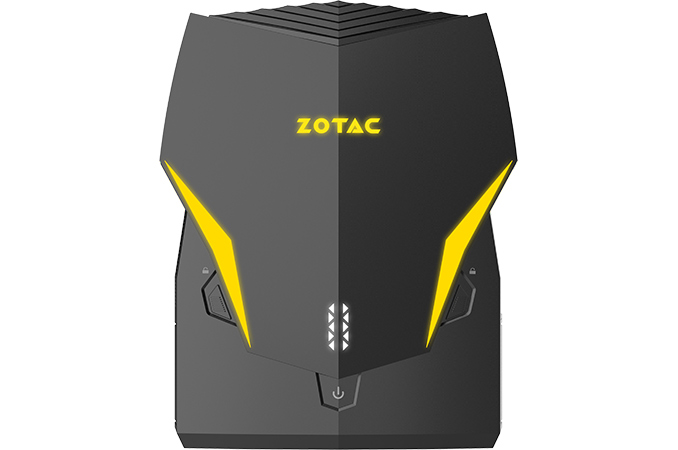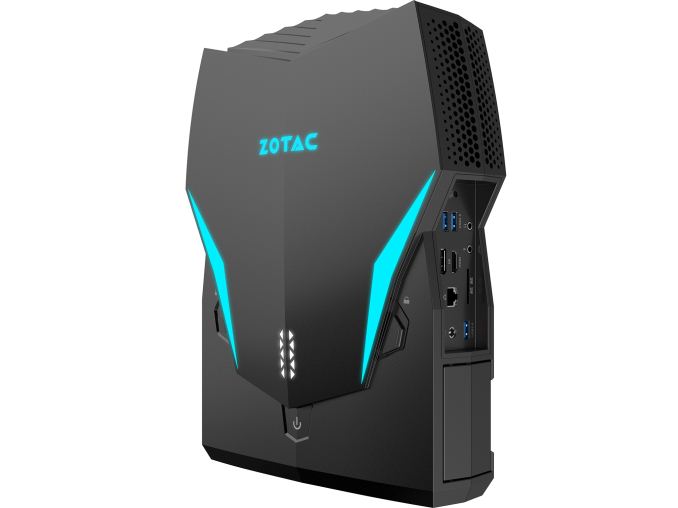ZOTAC Preps Second-Gen Wearable Backpack "VR GO" PC
by Anton Shilov on June 1, 2018 12:00 PM EST- Posted in
- Systems
- ZOTAC
- VR
- VR GO
- Computex 2018

Multiple makers of gaming PCs formally introduced their wearable backpack PCs for VR gaming at Computex 2016 and have never updated these systems since then. But apparently after two years, it is time for an upgrade. ZOTAC announced on Thursday that it would demonstrate its VR GO 2.0 system at Computex 2018 next week.
Having learnt from the first-generation VR GO, ZOTAC made its second-gen wearable backpack PC smaller and lighter than the original one. ZOTAC intends to disclose final specs of the unit at Computex (so stay with us), but it's likely that the new PC will be based on Intel’s Coffee Lake CPU with up to six cores, along with various SFF or mobile components (e.g., SO-DIMMs, mobile GPUs) to make the system small and more energy efficient.
The new PC retains one of the key features of the original VR GO computer (besides its wearable nature, of course) — autonomous operation enabled by built-in batteries. Meanwhile, just like its predecessor, the VR GO 2.0 can be used like a regular desktop PC: its form-factor allows it to be laid out on a desk either vertically or horizontally and all the ports will remain accessible. Speaking of ports, the new VR GO is equipped with one Thunderbolt 3/USB Type-C header, six USB 3.0 Type-A connectors, one GbE, two HDMI outputs, a DisplayPort, an SD card reader, as well as two 3.5-mm audio jack.
Following the general market trend, the VR GO 2.0 will feature ARGB lighting on the back to make the system not only feel better than the first-gen VR GO, but also look more impressive.
Preliminary specifications, ETA, and other details about the ZOTAC VR GO 2.0 will be disclosed next week at Computex, so stay tuned with us for additional information about the system.
| ZOTAC VR GO Comparison | ||
| VR GO | VR GO 2.0 | |
| CPU | Intel Core i7-6700T 4 cores/8 threads |
Intel Coffee Lake CPU up to 6 cores/12 threads (unconfirmed) |
| PCH | unknown 100-series | unknown |
| Graphics | NVIDIA GeForce GTX 1070 2048 stream processors 128 texture units 64 ROPs 256-bit memory interface 8 GB of GDDR5 8 GT/s memory |
Discrete |
| Memory | Two SO-DIMM slots 16 GB DDR4-2133 installed compatible with up to 32 GB of DDR4-2133 |
DDR4 |
| Storage | 240 GB M.2/PCIe SSD + one extra 2.5"/SATA bay |
unknown |
| Wi-Fi | 802.11ac Wi-Fi + Bluetooth 4.2 | 802.11ac Wi-Fi + Bluetooth |
| Ethernet | 2 × GbE ports (Realtek) | 1 × GbE ports |
| Display Outputs | 3 × HDMI 2.0 2 × DP 1.3 |
2 × HDMI 2.0 1 × DP |
| Audio | 3.5 mm audio in and 3.5 mm audio out | |
| USB | 6 × USB 3.0 Type-A (5 Gbps) | |
| Other I/O | DC12V-out for HTC Vive | |
| Dimensions | 410 mm × 270 mm × 76 mm 16.14 × 10.63 × 2.99 inches |
~330 mm × 220 mm × 90 mm 13 × 8.66 × 3.54 inches (unconfirmed) |
| Weight | update: 4.95 kilograms | Lighter |
| PSU | External | |
| Batteries | 2 batteries, rated at 95Wh, 6600mAh | unknown |
| OS | Windows 10 Home | Windows 10 |
| Price | $1999.99 | unknown |
Related Reading:













5 Comments
View All Comments
mukiex - Friday, June 1, 2018 - link
This makes WAY more sense in the world where Windows MR headsets exist.AllThings3D - Sunday, June 3, 2018 - link
I agree with mukiex, but I found a way for $10 to allow a "VR ready" laptop to be used as a mobile system. The only caveat is you need two external video outputs. ASUS I know has had mini display port (now I think they are using USB-3) and a HDMI 2 port, so find yourself a mini display port dummy plug that provide a ghost display and just 'Duplicate the laptop displays' with this port. You will also need to go into your settings ensure when you close the laptop lid you don't go into sleep mode, and ensure when in battery mode you are still delivery full performance. Doing this, provides you about one hour of mobile time, and working on a low cost 19VDC 6 AH battery source to power your laptop for another hour, that can be swapped out when depleted.Of course if you want to wear it on your back you need to come up with something that keeps the laptop exposed to ensure good airflow, but I did this by using a laptop metal mesh platform for angling your laptop and a backpack strap system for a leaf blower/fumigator . I will write an article one once my Velcro branded straps come in to secure it, but still allowing access to the keyboard when lift the lid and I test the adjunct battery system. I am also in discussion with OEM laptop maker to create a custom plate for their laptops. The whole thing cost me about $50 (not including the ASUS laptop, but there are now low end GTX1060 models for less than $1000).
kevinkruse26 - Monday, June 4, 2018 - link
While journeying the large subject parks of Disney, Warner and standard the special mild results usually have been very outstanding. Disneys "Space Mountain" is a famous example for the use of fibre optic lights. They used numerous this fibre optics there, e. g. for a transferring comet tail or a starry sky. Due to my work for a special https://www.mycourseworkhelp.co.uk/ purpose equipment manufacturing organization as soon as we had a lot of fibre optic leftovers that have been used for optical sensors. This becomes the initiation to build my personal starry sky.jordandavidson - Saturday, July 21, 2018 - link
Of course in case you need to put on it for your lower back you need to provide you with something that keeps the laptop exposed to ensure exact airflow, but I did this via the usage of a pc metal mesh platform for angling your computer and a backpack strap gadget for a leaf blower/ fumigator. https://www.britishessaywritingservice.co.uk/jamesandersonpmp - Tuesday, February 12, 2019 - link
Awesome Machine but i want something big in ram. I've been looking for a plug-in like this for quite some time and was hoping maybe you would have some experience with something like this.Please let me know if you run into anything. I truly enjoy reading your blog and I look forward to your new updates https://www.papersjunction.co.uk